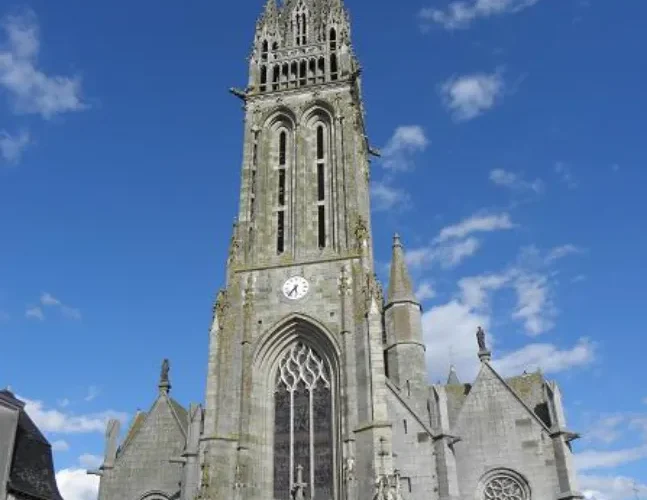Introduction

The Basilica of Our Lady of the Assumption of La Guerche-de-Bretagne , located in the heart of the former walled city of La Guerche-de-Bretagne in France , is a Gothic building from the 13th , 14th AND 16th CENTURIES , restored and enlarged in the 19TH century . A pilgrimage sanctuary with local influence, it is part of the Archdiocese of Rennes, Dol and Saint-Malo.

Genesis of Marian worship
Devotion to Our Lady of La Guerche dates back to the 10TH century . The current statue dates from the 17TH century : hollow, polychrome, it is carved from a tree trunk. The [Mary ( mother of Jesus)|Virgin Mary]] carries the Child Jesus in her arms who caresses her. She was crowned onJune 17, 1937by Mgr René-Pierre Mignen , Archbishop of Rennes, Dol and Saint-Malo , under the presidency of Cardinal Emmanuel Suhard , Archbishop of Reims , originally from the neighboring village of Brains-sur – les-Marches
The Castle Chapel to the Collegiate Church
The first mention of a chapel in La Guerche which was dedicated to Our Lady is assured in 1152. However, it would seem that a religious building existed from the 10TH century . The first lords of La Guerche donated this castle chapel to the Saint-Melaine abbey in Rennes before William II FOUNDED theMarch 25, 1206, on the feast of the Annunciation, a collegiate church. Notwithstanding this early existence of a place of worship, La Guerche was not erected into a parish until the French Revolution , its territory previously falling under that of Rannée.
The Parish Church to the Basilica
If a civil decree of theApril 1 , 1791 created the parish of La Guerche by dismembering the territory of that of Rannée, it was necessary to wait for the concordat period for Mgr Jean-Baptiste-Marie de Maillé de La Tour-Landry to proceed with its canonical erection, in 1803. Seat of the deanery, the church of La Guerche was subsequently erected into a minor basilica onMarch 12, 1951by a brief from Pope Pius XII 6. In the meantime, it is the subject of a procedure for classification as a historical monument by decree datedNovember 15, 1913.

At the gateway to Brittany, the basilica of La Guerche, dominated by a tall spire inspired by that of Folgoët or Cornish models, is part of a dual signaling desire: the expression of a conquering church after the revolutionary interlude and the affirmation of Breton particularism in a marching zone. Built in Caen stone by the architect Arthur Regnault from 1869 to 1873, it extends a granite bell tower porch flanked by two aedicules pierced with ogival doors, rosettes, and finished with tapered gables. This spire culminates at some 75 meters.
The basilica adopts the style of churches with multiple gables, which is very widespread in Upper Brittany and particularly in the Vitré region. Without a transept, the southern flank is enlivened by six dressed gables, decorated with curly cabbages and gargoyles, separated by buttresses topped with pinnacles. An old tower occupies the south-east corner of the aisle and the choir. Of Romanesque origin, flanked by powerful corner buttresses, it has a steep slope and facings of red sandstone. Topped with an inelegant slate roof after the collapse of a previous spire in 1705, it contains one of the oldest ribbed vaults in Brittany. A choir with canted sides from the 13th – 14th CENTURIES completes the building. Of Norman inspiration , it was decorated in the 19TH century with three small dormer windows enclosing mullioned windows with flamboyant tracery.
Interior
Notre-Dame de La Guerche has a basilica plan. The large, blind nave, 30 m long and 11.40 m wide , is flanked by side aisles and finished with a pentagonal chevet. The central nave, from the 16TH century , has a panelled vault, decorated with sablières and held by tie rods with sculpted engoulants (animal, monster or human heads). The lighting, indirect, is provided by the windows of the six bays of the side naves. The latter are vaulted, the south side aisle, contemporary with the nave having served as a model for the north one, built, as well as the sacristy, by the architect Nugues, from 1860 to 1863. A broken triumphal arch gives access to the 14TH century choir , abundantly lit by three large ogival windows. This apse was also raised by Arthur Regnault in 1888 and fitted with three elegant mullioned dormers.
The Stained Glass Windows

Four stained glass windows from the 15th , 16th AND 17th CENTURIES adorn the south aisle of the basilica. Mutilated by the Huguenots in the 16TH century , although repaired on several occasions and restored in 1905, they are among the most beautiful in Ille -et-Vilaine .
As such, they have been classified asMay 11, 1907 :
Fragments of a Tree of Jesse (eleven 15TH century panels ) occupy the window of the second bay of the south aisle. They depict the Duke of Alençon, John I , his wife, Marie of Brittany , eldest daughter of the Duke of Brittany , John V of Brittany , and their coats of arms;
The stained glass window of the Last Judgement (1537), in the third southern bay, shows Christ sitting on a rainbow, the Virgin Mary and Saint John the Baptist kneeling, Saint Michael , angels and demons, as well as the elect and the damned. A 16TH century coat of arms , with the arms of the Dukes of Brissac , lords of La Guerche in modern times, is placed in the lower panels;
In the next bay, the stained glass window has as its theme the coronation of the Virgin , the four evangelists and God the Father . These fragments date from the 15th AND 16th CENTURIES . The arms of the du Guesclin family , lords of La Guerche from 1379 to 1390, are next to those of the Dukes of Brissac;
The last listed stained glass window is located in the penultimate bay of the south aisle. Dating from 1536, its subject is the Annunciation and the Coronation of the Virgin . Decorated with the shield of Yves Mahyeuc , Bishop of Rennes, it is one of the rare contemporary portraits of the prelate presented by Saint Yves Hélory de Kermartin.
Furniture
The choir of the collegiate church retains a double row of 9 carved wooden stalls which are the subject of a classification measure as historical monuments. Originally numbering 24, these high stalls were undoubtedly preceded by low stalls, a rood screen closing the canonical space. The latter was destroyed in the 18TH century , some elements being relegated to the bottom of the nave to constitute an organ gallery which has since disappeared.
In the Renaissance style , these stalls have elegant backs decorated with arabesques populated with various animals and plants, Hercules, centaurs, griffins and other fantastic chimeras. A canopy , of great finesse of execution, supported by foliated uprights, crowns the whole.
In the south, the misericords represent the various scenes of the earthly Paradise the creation of Adam and Eve , the temptation, the dismissal… In the north, the misericords are dedicated to the capital sins in extremely picturesque scenes.
Presenting the coat of arms of the Dukes of Alençon , lords of La Guerche around 1520, these stalls, which date from the period 1505–1527, by their decoration recall those nearby of Champeaux . They constitute with the tomb of Bishop Thomas James , located in the Cathedral of Dol-de-Bretagne , one of the first manifestations of the Renaissance in Brittany.
The Organ
The organ , built by the Louis Debierre factory in Nantes in 1888-1889, has 19 stops (16 real stops) spread over two manual keyboards and pedal. Inaugurated by Camille Saint-Saëns onApril 3, 1889, it occupies the back of the apse, between the two rows of stalls. The neo-Renaissance buffet and the instrumental part were classified as historical monuments onApril 14, 2005. It has the particularity of being mounted on rails to facilitate the tuning of the reeds.
Work of Art in The Church
Recumbent statue of Guillaume II de La Guerche (founder of the collegiate church, died in 1223), exhumed in 1889 and heavily restored since, Virgin of Pity , polychrome wooden statue from the 16TH century (stolen), Louis XV style chair.
Feast Day
Feast Day : 15 August
The Assumption of the Blessed Virgin Mary (Assumptio beatae Mariae Virginis) is the biggest Marian feast of the Catholic Church, which is celebrated on August 15, and is also the feast of the patron saint of Hungary. Its oldest name is dormitio (falling asleep) or pausatio (resting), i.e. the day of Mary’s slumber and death.
Church Mass Timing
Every Sunday : 09.30 AM
Church Opening Time:
Monday : 9:30 am–12 pm
Tuesday : 9:30 am–12 pm
Wednesday : 9:30 am–12 pm
Thursday : 9:30 am–12 pm
Friday : 9:30 am–12 pm
Saturday : 9:30 am–12 pm
Sunday : Closed
Contact Info
Address :
35130 La Guerche-de-Bretagne, France
Phone : +33 2 99 96 22 10
Accommodations
Connectivities
Airway
Aéroport Rennes Bretagne to Basilica of Our Lady of the Assumption La Guerche-de-Bretagne Distance 44 min (46.4 km) via D463.
Railway
Rennes Railway Station to Basilica of Our Lady of the Assumption La Guerche-de-Bretagne Distance 48 min (43.1 km) via D463.








